July 30, 2004
Air Date: July 30, 2004
FULL SHOW
SEGMENTS
Kerry in a Coal Mine
View the page for this story
Democrats hope John Kerry's strong environmental record will carry him to the White House. But it might turn away voters in a few key swing states where the coal industry still dominates. Washington correspondent Jeff Young reports on what happens when Kerry the contender meets King Coal. (11:30)
Off-Season
View the page for this story
Seaside towns are magnets for tourists during the peak of summer. But when the temperatures drop, the tourists fall away and the towns return to themselves for the winter months. It’s during this off-season when travel writer Ken McAlpine decided to tour these places and experience the local way of life. Host Steve Curwood talks with McAlpine about his new book "Off-Season: Discovering America on Winter’s Shore." (13:30)
Dancing Gnats
/ Jeff RiceView the page for this story
Gnats are those little bugs that annoy you in the summertime. But if you know the trick, gnats will actually move at your command. Jeff Rice reports from Idaho. (03:00)
Emerging Science Note/Rhinos Rebound
View the page for this story
Living on Earth’s Jennifer Chu reports on efforts to rehabilitate the black rhino. (01:20)
Can This Tribe Be Saved?
/ Alan WeismanView the page for this story
In the extremely remote region of the Ecuadorian Amazon the Zapara tribe, much reduced in numbers, tries to revive its language and culture just as the oil industry is approaching their territory. From the Homelands Productions series, “Worlds of Difference,” Alan Weisman reports on the tribe’s uncertain fate. (15:00)
This week's EarthEar selection
listen /
download
Show Credits and Funders
Show Transcript
HOST: Steve CurwoodGUESTS: Ken McAlpineREPORTERS: Jeff Young, Alan WeismanNOTE: Jennifer Chu
[THEME MUSIC]
CURWOOD: From NPR, this is Living On Earth.
[THEME MUSIC UP AND UNDER]
CURWOOD: I’m Steve Curwood. Presidential contender John Kerry is out to make coal country democratic country by promising new technologies that would make coal people- safe and planet-friendly.
KERRY: Do you know that that this administration is going backwards in the quality of air in America? Well, guess what? We could put a lot more people to work in the state of West Virginia if we were willing to increase our efforts for coal, for coal clean technology, clean coal technology.
CURWOOD: But clean coal is years away, and some coal miners say Kerry’s immediate environmental agenda would do in their industry.
RAINES: I believe he’d allow it to be over-regulated to the point that we couldn’t mine it economically and we’d just gradually fade away.
CURWOOD: It’s John Kerry and King Coal--this week on Living on Earth. Stick around.
[NPR NEWSCAST]
ANNOUNCER: Support for Living on Earth comes from the National Science Foundation and Stonyfield Farm.
Kerry in a Coal Mine
CURWOOD: From the Jennifer and Ted Stanley Studios in Somerville, Massachusetts, this is Living on Earth. I’m Steve Curwood.
As John Kerry's run for the White House swings into high gear after the Democratic Convention, a key concern for his campaign is coal country: the battleground states of Pennsylvania, Ohio and West Virginia. In the 2000 campaign Al Gore was outspoken about the dangers of climate change and dirty air caused by coal-fired power plants. And some pundits say that stand cost him West Virginia and its five electoral votes - five votes that would have given him a victory.
Once again, folks in coal country are nervous about the new Democratic nominee, whom Mr. Gore praised on the convention floor.
GORE: He had the best record of protecting the environment against polluters of any of my colleagues -- bar none.
CURWOOD: Living on Earth's Washington correspondent Jeff Young reports on what happens when the new contender John Kerry meets old King Coal.
YOUNG: On one side of the road the bumper stickers read, "I love mountains." On the other they read, "friend of coal." Only in coal country could statements so innocuous become political fighting words.
[SOUND OF CROWD MILLING]
YOUNG: At this roadside demonstration on a muggy afternoon in Shepherdstown, West Virginia, those slogans summed up the divided sentiments of a region tied to a coal economy and suffering coal's environmental damages. Speakers like Larry Gibson lashed out at the Bush administration's view of coal as cheap energy.
GIBSON: Ah, people, if you only knew the true cost of coal and what it’s costing the people. You can't put it on a piece of paper. You can't write it on a piece of paper. Look into a man's heart or a family's heart when they're losing everything--they’re losing their water they’re losing their land they’re losing their houses from dynamiting.
YOUNG: Gibson's family property is nearly surrounded by the blasting and earthmoving of a massive mountaintop removal mine. That form of surface mining blasts the tops from hills to expose coal seams. The waste rock and dirt is dumped into valleys. It's buried or polluted 1,200 miles of Appalachian streams and flattened some seven percent of the region's forested mountains.
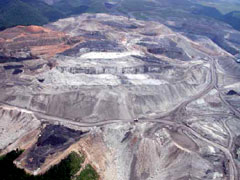
Mountaintop removal mining in southern West Virginia. (Photo: Vivian Stockman, OVEC)
YOUNG: Across the highway from where Gibson is speaking, mining officials and supporters met in an air-conditioned conference room to promote coal for the nation's energy security.
HAMILTON: Coal is just sitting in the catbird seat, if you will, fully prepared to take advantage of the shared goal of becoming more energy independent.
YOUNG: Chris Hamilton is vice president of the West Virginia Coal Association and he has ample reason to support George Bush again in '04. The administration has boosted mountaintop mining by changing clean water rules, scrapped clean air restrictions on coal fired power plants, and let the power industry help write new rules on mercury emissions. And Bush rejected the Kyoto Climate Change Treaty, which would have had big effects for a greenhouse gas source like coal.
HAMILTON: I will say that the administration's performance is very commensurate with the expectation that was based on campaign promises and campaign positions.
YOUNG: The coal supporters have studies showing every job in a mine has a broader economic effect on eight other jobs in the region. Environmentalists point to surveys showing a little more than half the area's residents oppose mountaintop mining. Such sharp divisions make these mining states a minefield for a candidate like John Kerry who must please environmentalists in his base while reaching out to coal-patch voters.
To understand what's at stake it's helpful to take a quick trip back to the last presidential campaign. Candidate George Bush was a frequent visitor to coal states like West Virginia where he played up his support for coal.
BUSH: Good folks of this state, no matter what your political party understands what I understand: the importance of coal. That coal is gonna help energize America. And that requires working with the people of West Virginia and that requires clean coal technologies to make sure the good folks of this state can find work.
YOUNG: Bush pledged two billion dollars over 10 years to develop ways to reduce the pollution from burning coal, an approach known as clean coal technology. Warming up to coal paid off for the Bush campaign. The mining industry pumped almost four million dollars into Republican coffers and some power industry executives were among Bush's top fundraisers.
With just a few days before the election, Bush returned to West Virginia, a state with twice as many Democrats as Republicans, and made this swaggering prediction.
BUSH: Who would have thought that the Republican candidate for president was gonna be able to say this: I'm gonna carry West Virginia!
YOUNG: Bush was the first Republican challenger to win the state since Herbert Hoover. If Gore had won there it would have meant more than all the hanging chads in Florida.
ROBERTS: Let's face it. If he'd won West Virginia he'd be president of the United States right now.
YOUNG: That's United Mine Workers of America President Cecil Roberts. Roberts says miners’ misgivings about Gore's environmental policy, and Bush's relentless attacks on that theme, cost Gore the state. The UMWA endorsed Gore in 2000 but many rank and file miners did not vote their union's choice. Roberts says a sticker he saw on a pickup summed it up.
ROBERTS: It was a coal miner and in back of his truck he had a sticker that said ‘I'm a coal miner and I vote. Just ask Al Gore.’ So clearly, the message that got down to coal miners back four years ago was if you vote for Al Gore you're voting yourself out of a job.
YOUNG: So what message will miners get about John Kerry, who also supports action on climate change and opposes mountaintop removal mining?
ROBERTS: John Kerry has already spoken to this issue of coal. He has on his web site a very clear and distinct position on coal and it does not eliminate coal from the energy equation in the United States. So anyone who wants to make decision based on the environment, based on keeping their job, the economy of these coal-producing states, I think they can feel very comfortable with John Kerry.
YOUNG: The UMWA has endorsed Kerry early in this campaign. But even if Roberts can deliver all his union's votes, they represent only about 40 percent of the country's roughly 80,000 coal miners. And non-union miners seem much less inclined to vote Kerry.
[SOUND OF BULLDOZERS AND DUMP TRUCK]
YOUNG: Pritchard Mining's strip mine near Charleston, West Virginia is one of the non-union operations in the state. Mine manager Rocky Hackworth watches the ‘dozers and dumptrucks work their way through rock and dirt to coal.
HACKWORTH: First you have to clear the trees off the top, and then you bring ‘dozers in, clean off and level the bench to level it off, drill and shoot, then the ‘dozers or endloaders come in and start moving the rock off.
YOUNG: Hackworth admits it looks like a bomb went off. But this area was first mined decades ago and left in a mess of highwalls and bad water. Hackworth calls himself an environmentalist and says his company will leave this site better than it was.
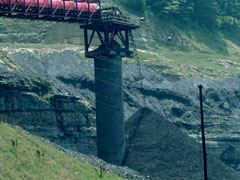
(Vivian Stockman, OVEC)
[MACHINERY SOUND FADES UNDER]
YOUNG: Hackworth has been in mining for 23 years. He's a registered Democrat but voted for Bush in 2000 and plans to do so again. He's concerned about Kerry's stance on climate change and support for the Kyoto Protocol.
HACKWORTH: It would end up shutting down the industry. We have several state and federal agencies that govern us and inspect us on a regular basis and we try to adhere by the laws but with the Kyoto treaty and clean air it would almost eliminate the burning of fossil fuels. And my question is, if we eliminate one of our big sources of energy then where do we make it up?
YOUNG: Mine supervisor Larry Raines is a Republican who votes coal above all other issues. He thinks a Kerry presidency would doom his industry.
RAINES: I believe he’d allow it to be over-regulated to the point that we couldn’t mine it economically and we’d just gradually fade away. I just couldn’t vote for a person that’s against the way I make my living and feed my family. That’s just what it boils down to.
YOUNG: When John Kerry made a visit to the heart of coal country in Beckley, West Virginia, his speech did not include mountaintop removal or climate change. But he did draw a link between coal and clean air issues.
KERRY: Do you know that the biggest source of hospitalization of children in America in the summertime is asthma? Do you know that that this administration is going backwards in the quality of air in America? Well, guess what? We could put a lot more people to work in the state of West Virginia if we were willing to increase our efforts for coal, for coal clean technology, clean coal technology.
YOUNG: Sound familiar? Clean coal is the same phrase Bush used on the coal campaign trail in 2000. But Kerry promises $10 billion for clean coal, five times the Bush commitment. Bush has put hundreds of millions of dollars into coal research. But critics in Congress say he's fallen far short of his campaign promise. Chief among those critics is West Virginia's powerful senior senator, Democrat Robert Byrd. Byrd launched the clean coal program in the '80s and in a recent Senate hearing Byrd told Bush's energy secretary the administration is nowhere close to its $2 billion target.
BYRD: Now you’re looking at the daddy of the clean coal technology program. I understand what those words mean. I understand what the president meant when he said ‘em. He said I’m going to ask the Congress for $2 billion. A promise made is a debt unpaid. That promise was made, the words are etched in stone. We expect that promise to be kept. It’s not being kept.
YOUNG: While Byrd presses Bush on clean coal funding, some Kerry supporters are in an awkward spot, too. Environmental groups have a long record of bashing clean coal. In 2000, the Sierra Club called it an Orwellian term -- greenwash for dirty energy. League of Conservation Voters President Deb Callahan called clean coal an oxymoron. Both those groups have endorsed Kerry. And now that Kerry is endorsing clean coal, LCV President Callahan is learning to like the idea -- or at least the Kerry version of it.
CALLAHAN: When John Kerry talks about quote-unquote clean coal, it’s different because he's looking at the whole fuel cycle. You know, it's a shame they're using the same term because they're really talking about two different approaches here.
YOUNG: In Callahan's view, the Bush version of clean coal mostly aims at reducing a few air pollutants. She says Kerry's program would go beyond that to also capture coal's greenhouse gases.
CALLAHAN: Thus coal, while we’d like to still consider it a transitional fuel, we believe that there are technologies that can come to the fore that can allow us to burn coal without exacerbating our climate change problem.
YOUNG: The Bush campaign claims the administration is already working toward that goal with its FutureGen project, a billion-dollar quest for a zero-emissions coal power plant. If the line between the Bush and Kerry proposals on burning coal seems a bit murky, Callahan says the difference is clear when it comes to how companies get the coal out of the ground.
CALLAHAN: John Kerry has opposed mountaintop mining. He’s clearly got a very strong record and a clear vision in terms of public lands protection and landscape protection.
YOUNG: That's not something Kerry talks about on the campaign trail, especially not the part that goes through coal country where he's trying to embrace both the coal and the mountains that hold it. For Living on Earth, I'm Jeff Young.
[MUSIC]
CURWOOD: Coming up: a behind-the-scenes look at the locals who inhabit some of America’s seaside vacation meccas all year long. You’re listening to Living on Earth.
[MUSIC: Clint Marshall “?r2” &Mac185; SOUNDTRACK (Thrive – 1998) ]
Off-Season
CURWOOD: It’s Living on Earth, I’m Steve Curwood. Every summer, up and down the east coast, tiny little beach towns brace for the seasonal tide – not of the ocean, but of tourists. For three months out of the year otherwise sleepy hamlets grind into carnival gear as beachgoers descend on souvenir shops and try to snag a surfside strip.
Writer Ken McAlpine took a tour of these coastal tourist traps. But instead of an extended vacation during the height of the sight-seeing rush, he decided to see these towns without the tourist garnishes. His book is called “Off-Season: Discovering America on Winter’s Shore” and he joins me now. Welcome Ken.
McALPINE: Thanks for having me, Steve, I’m really thrilled to be here.
CURWOOD: So, you like to torture yourself, huh? You like to go to the most fun places of the summer in the middle of winter, at least when it’s too cold to have any tourists, huh?
|
|
CURWOOD: Could you map out for us your route? And why you picked the different destinations that you did pick? McALPINE: Sure, I’d be happy to. I started in Key West, Florida, and I finished in Lubec, Maine. And it took me five months. I started in October and I finished in, roughly, March. And as I was traveling I went south to north. I don’t know how many people said, “Why are you going north? I mean, what kind of idiot are you?” Because it gets colder. But I grew up on the East Coast and I worked for eight years as a lifeguard in a town called Ocean City, New Jersey. And to make a long story short, I spent eight summers there and I lived there year-round for four years, and I saw how the seasons changed and the town changed. And the town sort of returned to itself in the fall and the winter – a real sense of community. So I figured that that’s probably what might happen in some of these small coastal communities when I passed through them in, say, January, February, March. Especially the northernmost communities, when the harshest portion of winter had just squatted upon that community and unleashed all its fury. CURWOOD: You went to a lot of small towns that are often, usually overwhelmed by tourists in the summer. And you met some pretty amazing and stalwart characters (laughs). Talk to me about George Baker. This is the guy who was doing the salt marsh diving in Georgia. Now, how does somebody like George fit in with his community? And describe for our listeners who George is, and what exactly he was doing. McALPINE: Sure. George Baker was a gentleman first of all, I must say. He grew up -- I think he arrived on St. Simon’s, Georgia, when he was about ten years old. And I think he’s in his mid-50s now. So he grew up on St. Simon’s, and he’s a good old local boy. He’s got the build of a linebacker that’s sort of gone to seed. He’s got a bit of a belly, and he’s got a big drawl. But he’s got a heart of gold. His job, I think since about 1967, has been rescue and recovery. So what he does is what his title says -- he basically plucks stuff out of the Georgia Marsh. And few things absorb things better than the Georgia Marsh. So over the course of his career I guess the standard operation would be a fouled prop in a shrimp boat or something. I mean, the shrimp boat might get fouled in its own net, it might get fouled on something it ran over. And George goes into pitch blackness with sledge hammers and pliers and he frees these props. But the thing that struck me so much about a lot of these people, Steve, is they had just kind of consummate common sense. George will recover anything for a fee. He’ll recover, you know, if you lose a pair of sunglasses in the marsh or whatever. And he told me a story, and it’s in the book, about a tourist who came to him frantic because he lost a gold and diamond Rolex. Well, what the tourist doesn’t know about St. Simon’s Island is that – you know, George, first of all, promised him, “I guarantee you. You tell me where you lost it.” And the guy said, well, he was somewhere off this dock. “I guarantee you I’ll find that watch.” And so this guy’s probably thinking, “well, lordy, that water’s blacker than midnight, you know, this guy’s a genius!” So George sends him on his way and says, “I’ll have it to you by tomorrow.” Well, what the tourist probably doesn’t realize – and George knows from lifelong experiences – is that the tides in Georgia are huge. Six to ten feet difference between low and high. So George goes home, has a couple beers, waits till 3 a.m. when the tide goes out, and then walks out and picks up the Rolex. CURWOOD: (LAUGHS) McALPINE: So it’s that sort of common sense. But on the flip side, too, part of his job is sad, and it’s to recover bodies from the swamp; car accidents and that sort of thing. And he went to all kinds of extremes to find bodies for families so they would have some sense of closure. He’s a good-hearted fella with a supreme sense of common sense. And he was typical, Steve, of the kind of person I ran into. I mean it was just uncanny. And I think part of that is … it wasn’t luck, it’s just that there’s a lot of these folks that have – and I hate to use the word--escaped, but they’ve gone to these small communities because it’s a place where you can still be an individual. People just tend to accept people more in a smaller community, their quirks, probably because they have to. But, you know, the Georges, they’re multiplied ten-fold in places like – and St. Simon’s isn’t small anymore, unfortunately, it’s been discovered just like large parts of our coastline, and that’s another theme in the book. But individualism thrives in these places, and George, he’s up and down the coast in various way, shape or form. CURWOOD: In your travels, where did you see what felt like over-development? McALPINE: Ah, when I passed through the Outer Banks I went through Hatteras -- which fortunately has been saved since large parts of it are national seashore -- but then into places like Nag’s Head and Duck. And I’d been there in college, I went to the University of Virginia twenty-something years ago, and I saw the change when I came through. I picked up local newspapers and I saw ads for summer rentals where – and I saw these places with my own eyes from the outside – where there’d be seven bedrooms, five with Jacuzzis, one with two Jacuzzis, built right on the beach. CURWOOD: And it’s not the locals who live in these large houses. McALPINE: No, it’s not. It’s not. And they’re fighting tooth and nail to try to keep these places from being constructed, but it’s a tough, tough thing to fight. I mean, on St. Simon’s Island, George Baker told me, you know, all the good ole boys, they’re almost all gone. And the reason for that is when you’ve been earning $20,000 a year and somebody comes up to you with two million dollars and says, I’ll take your property, here’s the check, that’s a hard thing to resist. But, on the optimist side, I drove around St. Simon’s – which, actually, it’s probably too late for St. Simon’s, it’s still a beautiful place, but it’s a lot of planned communities and gold courses. There were signs tacked to the trees that said “Don’t Ask – Won’t Sell,” so there are still some people that look beyond the checkbook. And I’m not faulting people who accept those checks because those people have had a hard life and I don’t know what I’d do if somebody walked up to me and offered me two million. It’d be a difficult decision. And that sort of encapsulates the problem that faces the coast. CURWOOD: Now, how much self-awareness do these beachfront towns have about themselves? And, in particular, I’m thinking about, you know, how they all grouse about “the summer people” -- McALPINE: Uh-huh. CURWOOD: -- but if the summer people didn’t come, they wouldn’t be putting food on the table, and gas in their car, and piling up the shekels to think about retirement. So, how do they deal with that? McALPINE: You know, it really is a love/hate relationship. In the fall, they are supremely relieved. I mean, they’re literally pushing people across the bridge ‘cause they want their town back. When I lived in Ocean City, New Jersey, I saw this personally. I mean, we couldn’t wait for the tourists to leave. And they were especially my life’s blood ‘cause I worked as a lifeguard, and then I worked in the casinos at the health club. By the end of the summer, we were sick to death of the tourists. By winter, we were still pretty happy with ourselves, you know, by December, it was still really nice to stand in the middle of the street and have a conversation, or go surfing and there’d be two other people out and you’d know ‘em both. By March, you were pretty much on your hands and knees hoping to see some unfamiliar faces and a little bit of activity. So, I don’t think they actually bite the hand that feeds them, at least not confrontationally. But sure, it would drive me crazy if my town suddenly had 400 people in the line at the post office. CURWOOD: Now, Ken, it seems to me that the city was almost invented for the loner. You can get quite a bit of privacy in the huge crowd. But in a small town if you step back from people, people notice. And there’s a person in your book, I think his name is Tim Marshall, he’s the law on Tangier Island. And he stays apart from the community, I guess to have the authority to enforce the law. Why do you suppose he chooses to lead a life like that, in such a small, wonderful place – the folks there said that this is heaven on earth, that Tangier is the one place that they’d like to be. He chooses to be there but not be with the folks. McALPINE: Tim was probably, of all the people I met, the one I admired the most. He’d grown up on Tangier. Tangier is a really small island in the Chesapeake Bay. It’s the sort of place where a family goes back eight generations. He chose to be a marine policeman, and this is an island that still … tourism is big in the summer but in the winter it’s all about fishing, it’s all about crabbing, it’s all about oystering. This is their livelihood. And Tim is basically policing what amounts to -- in many cases literally -- his own brothers, relatives, uncles. He knows everybody on the water and he’s in such a difficult position. He either does his job, or everybody runs roughshod over him. And he is fair to a T. He lets everybody know where he’s coming from, and he has fined his brothers, uncles, you know, caught them on the wrong side of the border, levied heavy fines. You know, but a fine that will break a fisherman who’s having a struggling year. But he chose, and he stayed on this island where he was often ostracized. I mean, there was a place on the island called The Double Six, which was sort of the fishermen’s hangout; Tim is not welcome there. And he would ride by on his bicycle – most people ride bicycles, the island’s so small – and some of the fishermen turned their backs to him. But, in the end, I think he was, if not always liked, respected. I rode back on the mail boat -- which is the only boat that can get you to and from the mainland at that time of year, and I just barely got out of there before the whole island froze in -- and I was sitting across from a fisherman. And he says to me, you know, “what are you doing here on our island?” And I said to him – they speak sort of this strange mix of Billy Carter and Elizabethan English, it’s really a beautiful language -- and I told him what I was doing, and that I spent time with Tim Marshall. And you know, I knew, I was fairly certain that in the 18 years he’d been a marine policeman he’d probably busted this guy, ‘cause these guys are stretching the law, shall we say, to make a living for their families. They’re not averse to stretching the law, and I think I might do the same. And I told him I was spending time with Tim, and he looks me in the eye and he said, “Tim’s far, Tim’s far.” Which means, Tim’s fair. And I thought “right you are.” But he stuck by his guns and chose the life he did. CURWOOD: So, you’re living back on the West Coast. I’m wondering, could you have written this kind of book going up and down the California, Oregon and Washington Coast? McALPINE: I can’t really say about the Washington and Oregon Coast because I’m not that familiar with it, but I think the California coast, number one, doesn’t have the history, and number two, has too many transplants, like me! I don’t doubt that the place is full of characters, but I don’t think that there’s the same sense of history. And I think there’s a sort of seamless history that insinuates itself across the East Coast where, obviously, that sense of history doesn’t exist in the West. CURWOOD: “Off Season: Discovering America on Winter’s Shore” is Ken McAlpine’s latest book. Ken, thanks so much for taking this time with me today. McALPINE: Thanks for having me, Steve, its been a real pleasure and I really appreciate it. [MUSIC: Jimmy Buffett “Bananaland” BANANA WIND (Margaritaville – 1996)] Related link:
Dancing GnatsCURWOOD: Now, here's a story about one of those unheralded creatures of summer that play such a vital part of our planet's biological diversity – even if it seems that their only reason for existence is to annoy you. From Idaho, Jeff Rice explains how to have fun with gnats. RICE: Near the Boise foothills, the river ambles through the pastures and cottonwood groves. The late afternoon sun gives the marsh grass a soft focus. And a blizzard of gnats rises up near the water’s edge where a man is humming. [SOUND OF MAN HUMMING] RICE: But he’s not humming to himself, and there’s no real tune. ROBERTSON: [SHORT HUM] They just think I’m crazy [LAUGHS]. RICE: Dr. Ian Robertson is an entomologist at Boise State. One day, when we were talking about something completely different, he casually tells me that you can hum to gnats and in a sense, they’ll dance for you. ROBERTSON: [SHORT HUM] Just a simple hum [SHORT HUM]. RICE: He says it’s just one of those things that’s passed around from entomologist to entomologist. I believed him not just because I wanted to, but because it actually make sense. ROBERTSON: Well, the males have special organs that are basically antennae that can detect the wing frequency – the vibrations of the female’s wing. And so when a female flies into the area the males detect that and then all swarm towards her. And so when humming we’re trying to mimic the frequency of the wing beats of the female in terms of the sound it makes [SHORT HUM]. RICE: And it actually works. ROBERSTON: [SHORT HUM] RICE: Hum, the gnats move forward. Stop humming, they stop. Forward, stop. ROBERTSON: [SHORT HUM] RICE: Clouds of gnats shift direction like flocks of birds. Then they become liquid; they move and surge almost like a tide lapping against the shore. And the humming pulls them like an undertow. ROBERSTON: You see how just the whole group of them speeds up when that happens [SHORT HUM]. Then as soon as you stop they just go back into their normal flight pattern [SHORT HUM] RICE: [HUMS] ROBERTSON: [HUMS] RICE: It’s not long before we are controlling whole fields of them. It’s nothing short of beautiful, a swirling Busby Berklee musical of insects. And it gives me an idea: if this works with a couple of people, think of the possibilities. [TUNING SOUND] RICE: Hit it! [GROUP HUMMING] RICE: So did we attract any gnats? SINGER: I had one fly up my nose [LAUGHTER]. CURWOOD: Our lesson on how to make gnats dance was produced by Jeff Rice. Choral humming courtesy of the Boise State Chamber Singers.
Emerging Science Note/Rhinos ReboundCURWOOD: Just ahead: trying to reap a dividend of peace by bringing a culture and its language back from the brink of extinction. First, this note on emerging science from Jennifer Chu. [SCIENCE NOTE THEME] CHU: Efforts like South Africa’s Black and White Rhino Management and Conservation Project are helping to put the almost-extinct black rhino on the road to recovery. The black rhino population dropped to roughly 2,400 in the 1990s from previous estimates of 100,000 in the 1960s. The numbers fell when demand for rhino horn, used for everything from dagger handles to anti-fever medication, caused rampant poaching throughout Africa.
By keeping the groups small, female rhinos are kept in top breeding condition rather than being forced to compete with other females for food. Scientists hope such efforts will mirror the success of the black rhino’s bigger cousin, the white rhino, the world’s second largest mammal. The white rhino population once dwindled to just fifty a century ago, but today stands at 11,000. That’s this week’s Note on Emerging Science. I’m Jennifer Chu. CURWOOD: And you’re listening to NPR’s Living on Earth. ANNOUNCER: Support for NPR comes from NPR stations, and The Noyce Foundation, dedicated to improving math and science instruction from kindergarten through grade 12; Ford, presenting the Escape Hybrid, whose full hybrid technology allows it to run on gas or electric power. Full hybrid technology details at fordvehicles.com; The Annenberg Fund for excellence in communications and education; and, The Kellogg Foundation, helping people help themselves by investing in individuals, their families, and their communities. On the web at w-k-k-f dot org. This is NPR, National Public Radio. [MUSIC: Orbital “P.E.T.R.O.L.” ? SOUNDTRACK (Thrive – 1998)]
Can This Tribe Be Saved?CURWOOD: It’s Living on Earth. I’m Steve Curwood. The Zapara were once one of the largest tribes in the Amazon region of Ecuador. But by 1980 anthropologists considered them extinct, their culture erased in less than a century by disease, assimilation, and violence. What the academics didn’t know was that about 200 Zapara remained hidden in the jungle. Among them were five people who still spoke the native language. And after Peru and Ecuador resolved a 60-year border conflict in 1999, a few more Zapara were discovered in Peru. This group had already lost its language but among its numbers was the last living Zapara shaman. In 2001, the United Nations declared the Zápara a "masterpiece of the intangible heritage of humanity” and awarded them $70,000. As part of the series, “Worlds of Difference,” producers Alan Weisman and Nancy Hand traveled to Ecuador to see if one shaman, a few aging native speakers, and world recognition can save a dying culture. [FOREST-RIVER AMBIENCE, BIRDS WHISTLING] [SOUND OF MINGA BEING CALLED, POUNDING ON DRUM] WEISMAN: A young man, his face cross-hatched with red paint, circles beneath a thatched roof, beating a drum made from a hollowed palm trunk. [FLOCK OF PARROTS APPROACHING] WEISMAN: The dawn mist rising from the forest canopy carries his drumbeats to neighbors up and down the winding Rio Conambu, tributary to the Upper Amazon. [ROOSTER CROW; SOUND OF DRUM CLANGING] WEISMAN: He’s calling the neighbors to his village. The occasion is a “minga,” the Amazon equivalent of a barn raising. [BANGING OF MINGA DRUM IN BACKGROUND; CHICKENS PEEPING, MEN CONVERSING AND DRINKING IN FOREGROUND] WEISMAN: Today, the men will clear a field to plant cassava. But the minga must first begin with food and drink. Off to one side, Zapara women are frying catfish and perch. From a stew pot jut several boiled monkey paws. [COOKING SOUNDS OF MONKEY MEAT; FRYING, HOT OIL, KIDS FUSSING] WEISMAN: Everyone is served a ceramic bowl filled with a milky, alcoholic brew. This is chicha, prepared from cassava pulp the women chew first to make it ferment. Rarely do Zapara drink anything else, including water. [SOUND OF BABIES, WOMEN, LAUGHTER, SINGING] WEISMAN: While her granddaughters sip chicha and weave flowers in her long hair, Ana Maria Santi sings in the old language. She recalls that when Zapara ruled these forests, they considered monkeys their ancestors. But Quichua people who invaded from the highlands now dominate the Amazon. It was the Quichua who taught them to eat monkeys. And it is the Quichua language she must use with these children.
|

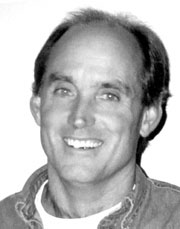 Author Ken McAlpine (Photo: Kathy McAlpine)
Author Ken McAlpine (Photo: Kathy McAlpine) 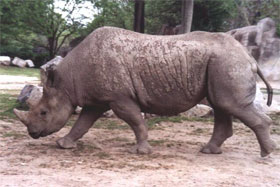

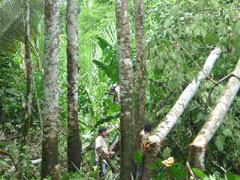 Clearing land to plant cassava. (Photo: Alan Weisman)
Clearing land to plant cassava. (Photo: Alan Weisman) 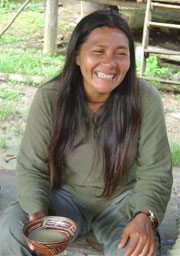
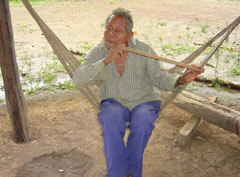
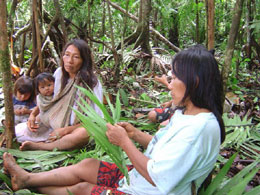 (Photo: Alan Weisman)
(Photo: Alan Weisman) 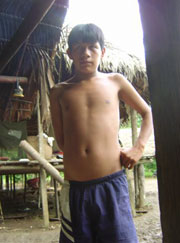 Blas Santi (Photo: Alan Weisman)
Blas Santi (Photo: Alan Weisman) 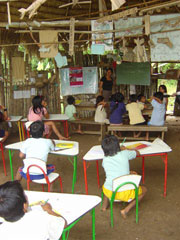 The Zapara School (Photo: Alan Weisman)
The Zapara School (Photo: Alan Weisman) 



